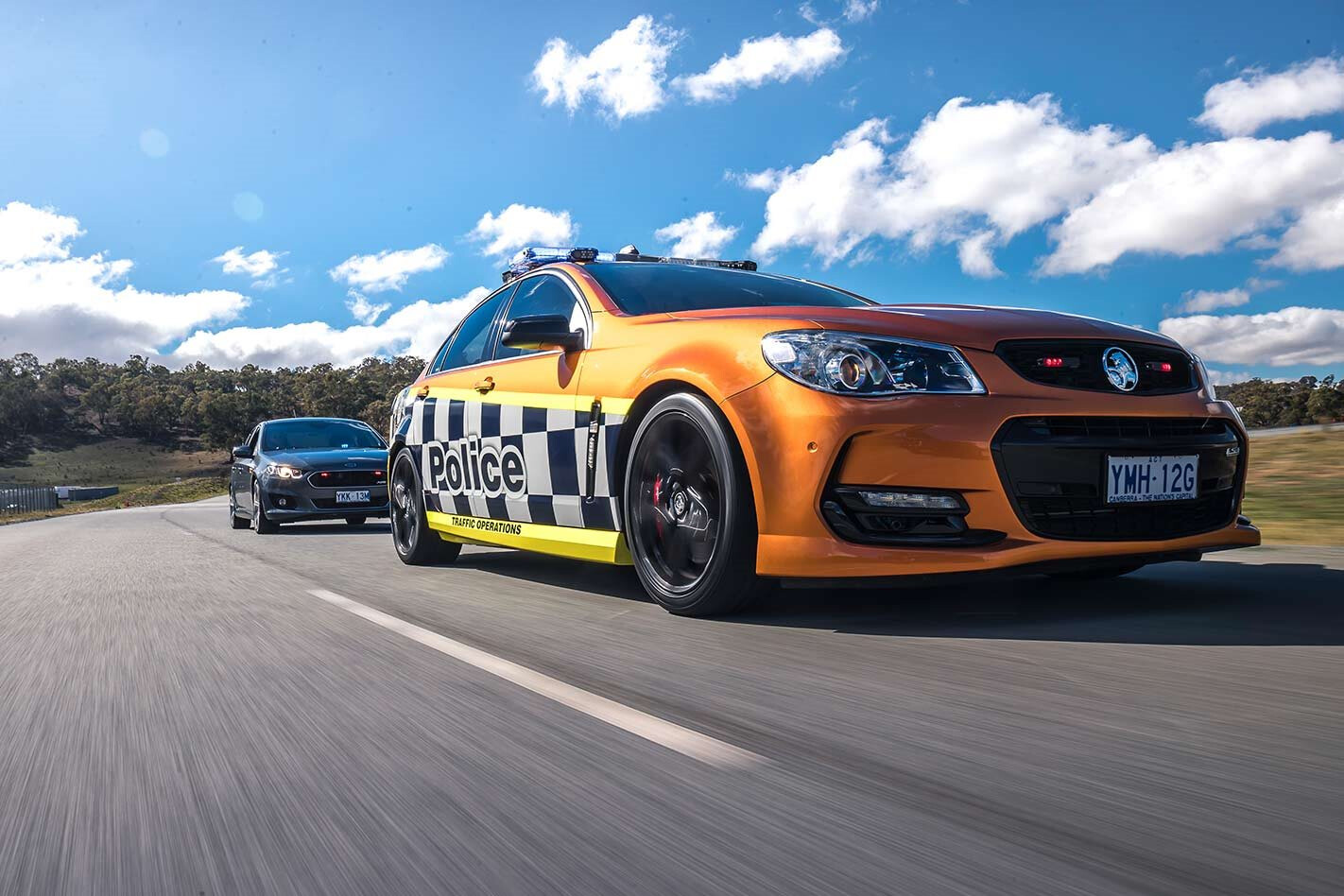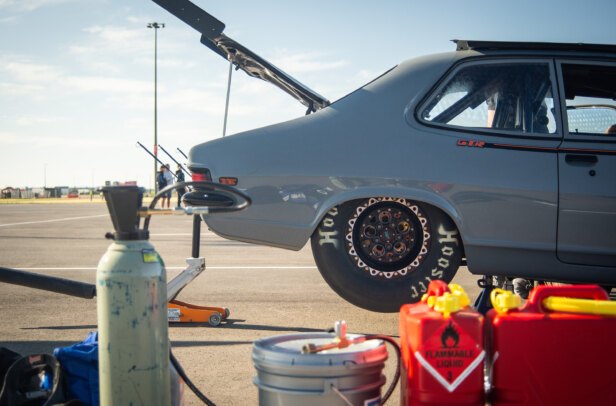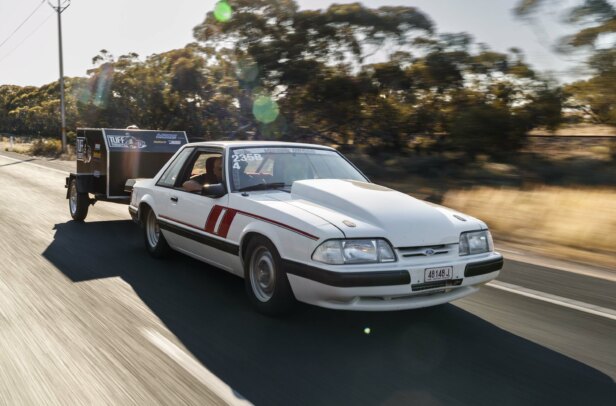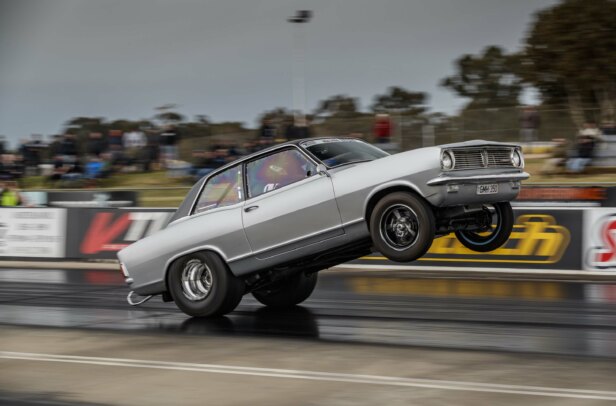FOR a fast-car nut, there are few things that grab the attention quicker than a mirror-full of red and blue lights: cherries and berries; whirligigs. You’re being lit up, wheeled, pulled over.
This article was first published in Street Machine’s 2020 Yearbook. Photos: Ellen Dewar & SM Archives
For decades, whenever your gaze darted from the road ahead to this scene in your rearview mirror, those fast-approaching police lights have more than likely belonged to the familiar, locally made Ford Falcon or Holden Commodore. But soon they will be no more.
With the last Aussie Ford Falcons made in 2016 and the final batch of Holden Commodores rolling off the line the following year, the ranks of our mighty home-grown police cars are thinning out. Retirement beckons the last of these Aussie-made lords of the bitumen.
Usually Ford or Holden and usually V8 (but with a few other brands and some fast fours and sizzling sixes sprinkled into the mix, too), these special-build police cars – known colloquially as chasers, interceptors or pursuit specials – have become part of the collective Australian psyche: respected and reviled, loathed and loved, thumbs-upped and middle-fingered in roughly equal measure.
The shit-stare needs little in the way of explanation: Few of us like to be pulled over and sternly told we’ve done the wrong thing before having our wallets lightened by the equivalent of a week’s wages or more. Nope, having the smile wiped from your face with a ‘tinny’ (Traffic Infringement Notice) is never much fun. But on the flipside, for decades, premium-performance ex-highway patrol vehicles have given thousands of us a leg-up into a late-model hot six or V8 for a bargain price.
In fact, the Aussie Ford and Holden police chasers have sometimes shared DNA with the manufacturers’ high-performance showroom cars. Despite the aura of our batch-built, ‘one of 500’-type Aussie race specials, the need to survive the rigours of police use rather than the desire for motorsport success was often the motivation behind the development of some of the higher-performance components under our Commodores and Falcons. Those ‘turn-and-burns’ that prowling highway patrol cars perform – pinging cars travelling in the opposite direction, braking heavily from the speed limit, performing a U-turn, chasing at high speed, braking to a stop and then idling for several minutes while someone gets written a ticket – are tough on cars. That’s why, over the years, hardware such as baffled sumps, upgraded brakes, lowered and stiffened suspensions and extra engine and transmission cooling capacity have all been integrated into many factory Holden and Ford cars built for police use.
Although Commodore and Falcon both have staunch histories of high-performance police-use vehicles, other Aussie-made cars have served our cops, too. Since the 1960s, cars as diverse as Minis, Toranas, Valiants and even Nissan Skylines have been used for various state police departments’ Special Traffic Patrol, Traffic Branch or Highway Patrol duties on Aussie roads.
From the first Aussie Falcon, the XK, in the early 1960s, Ford Australia seemed to work harder than Holden at building cars to make the coppers happy. Legend has it that the 1967 XR Falcon GT was a spin-off from Ford’s continuing efforts to service police fleets by providing Falcons (first with sixes and later V8s) with a bit more pep than standard.
Two- and four-door cop-spec Falcon V8s were available for the following 15 years, until 1982, when the international fuel crisis saw Ford kill its Aussie-made V8s, ending an era of legal police brutality on our streets: the 5.8-litre V8 Falcon cop car. With today’s 200kW mummy-mobiles, the on-paper 149kW from the last of these Falcs – the sleeper-spec XE Falcon GL – may seem a little weak now, but these cop-spec cars were an effective, and hence respected, tool of trade.
Holden quickly filled the gap left by Ford with its Commodore Police Pursuit Vehicle (yes, it really was named that), which arrived during the VH production run. Built in both six-cylinder and V8 guises, the pinnacle of performance for these police-spec cars was the high-output manual V8: Holden announced it had ‘Brock’ heads and manifold, a lightened flywheel and a swathe of other suspension, braking and interior tweaks for safer, sharper police use.
But Holden, too, was soon to kill its V8. That information slipped out during the launch of the VK Commodore in 1984, prompting the Street Machine-led ‘V8s ’til ’98’ petition. However, Holden had an alternative for our Aussie cops: The staunch Nissan-made RB30ET 3.0-litre fuel-injected turbo six arrived in the VL Commodore in mid-1986. The Commodore Executive sedan built with what was christened the BT1/National Police Pack and fitted with the optional turbo motor created a chaser that is, to this day, remembered with smiles by some serving senior – and of course many retired – cops.
Soon thereafter, the V8s returned to police duties, with both Holden and Ford launching fuel-injected 5.0-litre V8s. For much of the 1990s, Holden seemed to retain the upper hand for police use; after the V8 was launched in the VN Commodore, Holden launched independent rear suspension on VP sedans. This and other fleet-only equipment fitments from VP to VT gave police bosses the ability to specify an Executive V8 with SS-spec suspension and seats to create a no-nonsense highway patrol car with all the zing and not much bling.
Ford seemed to claw back some of the chaser market in the late 1990s, with the Tickford-tweaked EL Falcon XR8 (especially the later 185kW versions with a more tied-down rear suspension) and the new AU Falcon finding wider acceptance for highway patrol use across the country.
During the noughties, through the BA-BF and FG Falcons and the VT-VZ and VE Commodores, you’d seem to see just as many of one as the other, with the sizzling DOHC 4.0-litre Barra turbo under the bonnet of the Fords and the 5.7-litre (and later 6.0-litre V8s) in the Holdens.
Which brings us to the last Australian police cars: the Ford Falcon FG-X and the Holden Commodore VF II.
The Ford pictured here is an unmarked XR6 general duties car, corralled for us by the good folk at ACT Policing. But for most of the past two decades, the pinnacle of Ford’s police pursuit performance has been the XR6 Turbo. In final FG-X form, that meant 270kW/5250rpm and, for many cars built for police use, bigger FPV-spec front brakes.
The Commodore you see here is one of the last of the Australian Federal Police/ACT Traffic Operations’ Aussie chasers. These are extra special in that they weren’t built by Holden as National Police Pack (option 9C1) cars; they’re normal-spec SS-V Redlines complete with Brembo brakes and manual gearboxes, with suspension upgrades fitted by ACT Policing’s Traffic Operations to better suit their needs.
With the last cop cars from Holden and Ford being the fastest, safest, most powerful and most capable examples of the breed, the heritage of our Aussie chaser is ending on a high. Even with the many world-class vehicles to choose from as replacements, according to many officers, our home-grown interceptors have proved to be a hard act to follow.
It’s sad to know they’re almost gone; in fact, in some areas the last Australian police cars have already been replaced.
Aussie highways will never be the same.
BIG thanks to the crew at AFP/ACT Traffic Operations/Road Policing for their sensational assistance with this article.
COP IT SWEET
WE SPOKE to a NSW Highway Patrol officer about the last Aussie ‘pursuit specials’:
“I’ve always been interested in highway patrol policing because of my interest in cars. I’ve driven an XR6 Turbo at work, but only once – it was at the end of its run; it was decommissioned soon after.
“But at work, no one really had a bad thing to say about these cars. They have their differences: The Commodore is generally regarded as handling a little better, but the turbo Falcon FG and FG-X accelerated a bit harder. Then the VF Series II, with that 6.2-litre LS3, would catch up in the top end. They’re both very well-respected.
“The Holden and the Ford were perfect highway patrol cars. The new cars [BMW 530d and Chrysler 300 chosen for NSW Highway Patrol] – I can’t really criticise them, but it’s just not going to be the same.”
One of the Canberra crew had this to say:
“We expect and demand a lot from our cars in a general sense. I wouldn’t go so far as to say they are abused; our training teaches us the importance of vehicle sympathy and daily maintenance. We do strain our Redlines on the road, but they seem resilient in the way they survive our work routines without letting us down.
“We were incredibly spoiled with the Holden VF IIs; they are just such a good companion: they brake, handle and go hard without any of the issues the previous models seemed to suffer. I think the majority of pursuit drivers here are fond of the way these cars sound too. You just can’t find a better note than the deep-breathing bimodal LS3 in our Redlines at full noise, especially in comparison to all the European replacements.
“It is somewhat sad to think that these are the last years we will hear the roar of eight-cylinder Australian-made pursuit cars on our roads.”
THE AUSSIE COP CAR HONOURS ROLL:
HOLDEN VH COMMODORE
HOLDEN’S Police Pursuit Vehicle pack was available with a higher-output V8, with some components shared with the high-performance HDT/Brock road cars. After their cop careers, crafty caryard coves stretched the truth by advertising these as ‘Brock specials’.
VALIANT CHARGER
DURING the mid-1970s, the Valiant Charger (above) donned lights and sirens for highway patrol duties, particularly in NSW. Cars with the K10 option code scored E49 internals, high-performance suspension package, improved brakes, Sure-Grip LSD and more.
FORD XY FALCON
FORD’S first XR Falcon GT was inspired by and based on a police-pack V8 Falcon Deluxe. But the second-gen Falcon’s pinnacle of police performance was this (below): an XY Falcon 500 wrapped around an XY GT’s hi-po 5.8L driveline.
FORD XK FALCON ‘PURSUIT’
FORD Australia launched its US-designed, locally made Falcon in September 1960. Within a year or two, Ford was producing special versions for Victorian Police, replacing the Falcon’s standard 144ci six with a souped-up version of the optional 170ci mill. Named Pursuit by Ford, the cop version featured a different carby that liberated an extra 15hp (from 101 to 116hp). Was this Australia’s first proper pursuit special?
FORD XB FALCON 500
THIS mint XB (above) belongs to the Australian Federal Police Museum. Known as the Wolf in Sheep’s Clothing, these police XBs packed a 351/four-speed driveline, with upgraded suspension and brakes. In the glovebox was a second speedo, calibrated to 220km/h.
HOLDEN TORANA
HOLDEN’S Torana wasn’t just a winner at Bathurst in the hands of Peter Brock or a handy tool for Colin Bond’s rallying. From around 1970, Holden Torana GTRs were used as cop cars, too, with some carrying the XU-1-spec triple-carb motor.
HOLDEN VN COMMODORE V8
LAUNCHED in 1989, Holden’s new multi-point fuel-injected V8 swung punches that landed hard – 165kW at 5200rpm gave the cops plenty of go. Largely unchanged, that engine served our coppers for a decade through the VP, VR, VS and VT series.
NISSAN SKYLINE
NISSAN’S Special Vehicles Division-built Skyline GTS (right) was the choice for Apple Isle traffic/highway work, with Tasmania Police apparently ordering two batches of a half-dozen cars each: GTS1 in 1988 and GTS2 in 1990 (pic courtesy of the Tasmania Police History Museum).
HOLDEN VL COMMODORE EXECUTIVE TURBO
THE VL’s Garrett-boosted, 150kW, Nissan-built 3.0L turbo RB30ET was offered on all models, allowing police to order bare-bones cars that, in unmarked guise (without roof-mounted lights), could reportedly slip through the breeze beyond 210km/h
HOLDEN VF II COMMODORE SS
THE last Aussie cop car (opposite page). Holden continued building police-spec cars almost until the end of production in 2017. The 6.2L LS3 V8 in the VF II SS used by most states’ highway patrol delivered 304kW/570Nm.
CHEVROLET CAPRICE POLICE PATROL VEHICLE (PPV)
HOLDENS were liberally exported throughout Asia, Africa and beyond over the years, and more than a few ended up serving as police vehicles. The last of the line was the Chevrolet Caprice Police Patrol Vehicle (left), which filled the gap left by the venerable Ford Crown Victoria – until GM pulled the plug on Aussie production.
FORD EL II FALCON XR8
FORD’S late-’97 engine and suspension upgrades gave the EL II XR8 (right, pictured with its VS II Commodore counterpart) the punch and panache to be considered a viable alternative to Commodores for highway patrol use.
FORD BA FALCON XR6 TURBO
With 240kW/450Nm, the BA XR6 Turbo’s boosted twin-cam, four-valve Barra 4.0L six pretty much meant ‘don’t bother trying’ if you saw red-and-blues from one of these in your mirror.
FORD FG-X FALCON XR6 TURBO
FORD’S last Australian-made interceptor model was the FG-X Falcon XR6T claiming 270kW and 533Nm. The police package included bigger, cross-drilled and slotted Brembo front brakes borrowed from the FPV range.




Comments